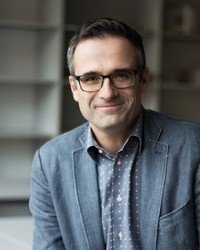EPFL+ECAL Lab: innovations should feel natural to users to be sustainable
Innovation is not about impressing people with the latest technologies. For the EPFL+ECAL Lab, an innovation is successful if a user forgets about the technology and instead focuses on the content.
Created in 2007, the EPFL+ECAL Lab is an innovation lab in Lausanne, located in the ECAL building of the University of Art and Design Lausanne, and belonging to the Ecole Polytechnique Fédérale de Lausanne (EPFL).
It aims to explore the potential of emerging technologies through design research:
“The main question for media innovation is how we can transform these new technologies into convincing experiences for the user,” says Nicolas Henchoz, director of the EPFL-ECAL Lab. “We tend to reduce innovation to technological performance – increased speed and increased functionality – and forget about how to make sense of them.”
Designers, engineers and psychologists work together in the Lab. They develop functional prototypes and evaluate the cultural and emotional impact of these prototypes on the end users.
Original failure
Nicolas and his team looked at many other initiatives for inspiration and translated their observations into a new and original approach:
“We had the chance to observe the good and the bad aspects of all of these models and then start our own. I always said ‘we will fail sooner or later, but at least it should be an original failure’.”
Inspiration for the Lab’s approach comes in large part from designers Jasper Morrison and Naoto Fukasawa. They coined the term ‘super normal’ to help find the essence of normality in design:
“This allows us to make something that is disruptive seem normal, almost like you’ve seen it before. When you reach this level, you can create things that last five to ten years. And that’s when you have a real return on investment for the user, for the company, for everybody.”
Content over technology
Although it’s far from easy, the EPFL-ECAL Lab has shown through several installations that it is possible to make people forget about the technology.
Through their work on immersive media, they tackled the challenge of getting from a cool 3D world that impresses people for a few minutes to a point at which people really start to look at the content. As soon as people forget about the technology, you start to see in which cases an immersive environment can be an added value.
The ‘History of Watch Making’ project went through several versions:
“In the first versions people were mostly seduced by the 3D environment,” remembers Nicolas, “but on the final one people were really looking at the content. For the innovation to last, it is important that the content is perceived as something that exists and not just as something fun.”
Emotional perceptions
Nicolas believes that many innovative projects turn into a disaster because most of the money is invested into developing the technologies, while almost nothing goes to thinking and experimenting about the ways in which users make sense of those technologies.
Innovations that feel natural incorporate the idea that experiences consist of different elements. Memories often include an image, a smell, some sounds; they are a kind of global sensation, a bit like dreams.
As an alternative, the EPFL-ECAL Lab approach doesn’t just take into account the storytelling level, but also the human perception through the so-called ‘landscape of sensation’:
“That is something very fuzzy that you acquire in the first weeks of your life. You still have it in your mind as an adult, but as we always speak with words when we try to convince the other with words and stories, we tend to forget this dimension.”
Industry partnerships
Clients’ fund about half of the work, the school the other half. They hire the EPFL-ECAL Lab to make sense of new technologies. Nicolas explains why these firms are interested in working with the Lab, despite the although it takes them more time and is therefore more costly:
“When you have new topics, new domains, new challenges; nobody knows. Working with a consultancy firm that doesn’t know how to deal with this and loosing your money because you end up in a dead end is probably not very efficient. And we have a very good return on investment for the company. It’s very important to be clear about what we can be good at and what we can provide as an advantage.”
The Lab accepts projects if they are convinced by it and if it brings new knowledge:
“Our lab is based on being hands-on, because design inspiration comes by doing, not only by thinking, so it must be with real people in a real case, but it must also tackle a real challenge for society.”
As a Lab, they deliver functional prototypes, but no final products. Although the prototypes are made in such a way that it is possible for the company to develop the product further if they wish to do so: “That’s also the only way to benefit society. Otherwise they have something that is really cool, but if there is no income, no funding, it will not last.”
CONTACT POINT

Nicolas Henchoz, Director, EPFL+ECAL Lab
Web: http://www.epfl-ecal-lab.ch/
Twitter: @epflecallab
